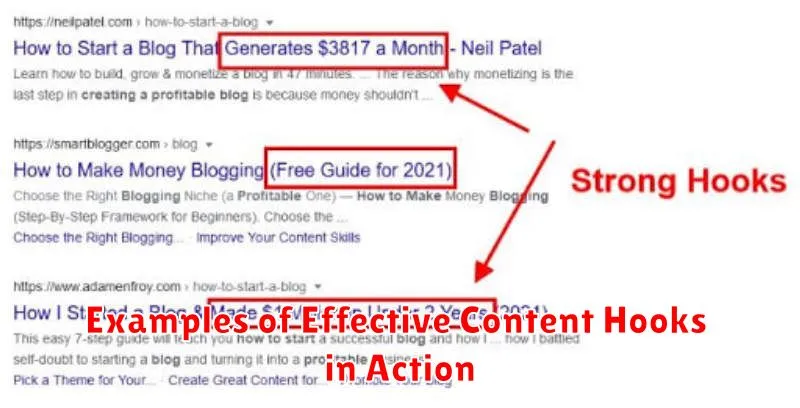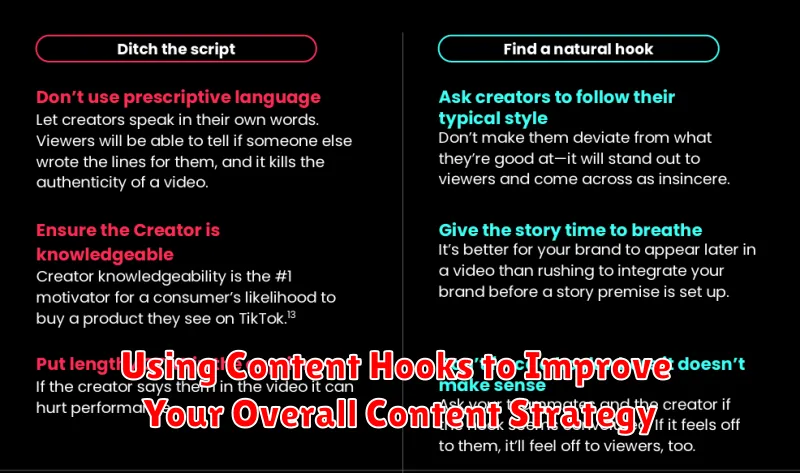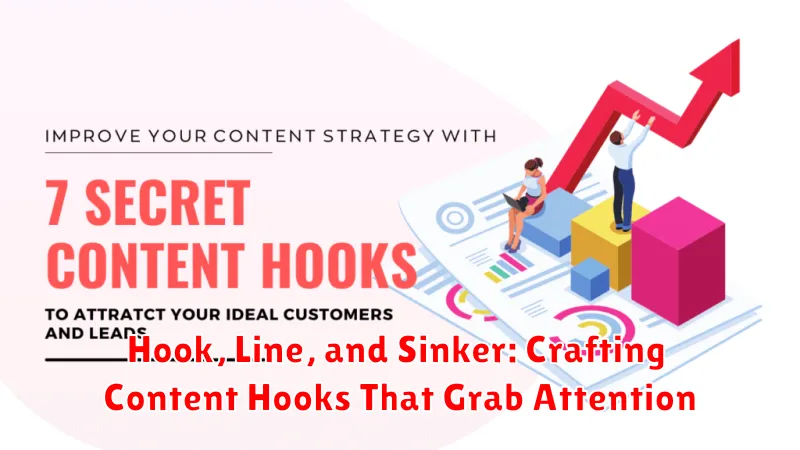In the bustling digital landscape, where content creation is ubiquitous, capturing your audience’s attention is paramount. Crafting compelling content hooks is the key to standing out from the noise. A hook, much like in fishing, is designed to grab the reader’s interest and reel them in. This article will delve into the art of creating effective content hooks that resonate with your target audience, ensuring your content isn’t just seen, but also consumed and remembered. We will explore various techniques and strategies to help you master the art of hooking your readers from the very first sentence, transforming casual browsers into engaged readers. Understanding how to construct powerful content hooks is essential for any writer, marketer, or content creator looking to maximize their impact.
From the elusive scroll-stopper to the compelling question, the world of content hooks is vast and varied. Whether you’re crafting blog posts, social media updates, or email newsletters, a well-crafted hook can significantly increase engagement and drive conversions. This article will provide a comprehensive guide to crafting content hooks that grab attention, exploring different types of hooks, providing real-world examples, and offering practical tips for implementation. Learn how to create hooks that are not only attention-grabbing but also relevant to your content, ensuring a seamless transition from the initial capture to a sustained reading experience. Master the art of the hook, line, and sinker approach to content creation and watch your audience engagement soar.
Understanding the Purpose of a Content Hook
In the vast ocean of online content, capturing your audience’s attention is paramount. A content hook acts as your first impression, the initial spark that ignites curiosity and encourages further engagement. Without a compelling hook, even the most meticulously crafted content risks being lost in the digital noise.
The primary purpose of a content hook is to grab attention within the first few seconds of exposure. It’s a strategic element designed to pique interest and draw readers into your content, compelling them to learn more.
A well-crafted hook serves several key functions:
- Reduces bounce rate: By captivating readers from the start, a strong hook encourages them to stay on your page and explore your content further.
- Increases engagement: A compelling hook sets the stage for increased interaction with your content, whether through reading, commenting, or sharing.
- Establishes relevance: A targeted hook immediately signals the value and relevance of your content to the intended audience.
Different Types of Content Hooks: From Questions to Statistics
A strong content hook can take many forms, each designed to pique a specific interest. Choosing the right type depends on your audience and the overall tone of your content.
Questions are a powerful way to engage the reader immediately. Posing a thought-provoking question related to their needs or pain points can draw them in, eager to find the answer within your content. For example, instead of stating “Project management is important,” try asking “Are your projects consistently delivered on time and within budget?”
Statistics offer a compelling way to grab attention and establish credibility. A surprising or relevant statistic can instantly highlight the importance of the topic. Instead of saying “Social media is popular,” consider “Over 4 billion people use social media worldwide.” This immediately provides context and emphasizes the scale of the phenomenon.
Anecdotes or short stories can create an emotional connection with the reader, making the content relatable and memorable. Sharing a brief, relevant story can humanize the topic and draw the audience in.
Statements of strong opinion or surprising claims can be highly effective, but should be used carefully. A bold statement can spark curiosity and encourage readers to continue to see if you can substantiate your claim.
Crafting Hooks for Various Content Formats: Blog Posts, Social Media, and Emails
Tailoring your hook to the specific platform and content format is crucial for maximizing its effectiveness. Each format demands a different approach due to varying audience expectations and engagement styles. Consider these distinctions when crafting your hooks:
Blog Posts
Blog post hooks often benefit from a slightly longer, more detailed approach. Consider using a thought-provoking question, a compelling anecdote, or a surprising statistic to draw readers in and encourage them to delve into the full article.
Social Media
Social media hooks need to be concise and attention-grabbing due to the fast-paced nature of these platforms. Short, punchy questions, bold statements, or intriguing visuals (when applicable) work well here.
Emails
Email hooks should be personalized and relevant to the recipient. Mentioning a past interaction, referencing a shared interest, or highlighting a specific benefit they’ll receive can significantly increase open and click-through rates. Clarity and a clear call to action are also essential.
Examples of Effective Content Hooks in Action

Let’s illustrate the power of compelling hooks with a few practical examples across different content formats:
Blog Post Hook: The Problem/Solution Approach
“Tired of cluttered closets? Discover these five simple steps to organize your wardrobe and reclaim your space.” This hook directly addresses a common pain point (clutter) and promises a solution, enticing readers to learn more.
Social Media Hook: The Intrigue/Curiosity Approach
“The biggest mistake you’re making with your morning coffee… and how to fix it.” This hook sparks curiosity and leverages a popular topic (coffee) to draw readers in.
Email Hook: The Personalized/Benefit-Driven Approach
“John, as a valued subscriber, you get exclusive access to our latest research on boosting productivity.” This hook uses personalization and highlights an exclusive benefit, making the recipient feel special and encouraging them to open the email.
Question Hook: Thought-Provoking
“What if you could double your website traffic in just one month? Find out how…” This hook presents a compelling question related to a desirable outcome, motivating readers to seek the answer within the content.
Testing and Refining Your Content Hooks for Maximum Impact
Creating a compelling hook isn’t a one-and-done process. Testing and refinement are crucial for maximizing their effectiveness. Analyzing performance data helps determine which hooks resonate most with your target audience.
A/B testing is a valuable method. Craft two different hooks for the same piece of content and present them to separate segments of your audience. Track metrics such as click-through rates, time spent on page, and conversion rates. This data-driven approach provides insights into which hook performs better.
Don’t be afraid to iterate. If a hook isn’t performing as expected, analyze why and try a different approach. Perhaps a question hook would be more effective than a statistical one, or vice versa. Continuous improvement based on data is key.
Pay attention to audience feedback. Social media comments, email replies, and other forms of engagement can offer valuable qualitative data. What are people saying about your content? Are they intrigued, or do they seem disengaged? Use this feedback to further refine your hooking strategies.
Common Mistakes to Avoid When Creating Content Hooks
While crafting compelling content hooks is crucial, certain pitfalls can diminish their effectiveness. Avoiding these common mistakes can significantly improve your chances of capturing your audience’s attention.
One frequent error is creating clickbait. While a catchy hook is essential, it must accurately reflect the content that follows. Misleading hooks can damage your credibility and lead to audience distrust.
Another mistake is being too generic. Vague hooks fail to pique interest and often get lost in the sea of online content. Specificity is key to making your hook stand out and resonate with your target audience.
Overly long hooks can also lose readers. Keep your hook concise and to the point, delivering impact quickly to grab attention before it wanes.
Finally, neglecting to tailor your hook to the specific platform and audience is a critical error. What works on social media might not be suitable for an email newsletter. Always consider the context and adjust your hook accordingly.
The Psychology Behind Content Hooks and Why They Work
Content hooks leverage fundamental principles of human psychology to capture attention and encourage engagement. One key principle is the curiosity gap. By presenting a piece of information that sparks curiosity but doesn’t fully satisfy it, hooks compel the audience to seek out the missing pieces.
Another crucial element is the principle of anticipation. Hooks create a sense of anticipation by hinting at valuable information or an engaging narrative to come. This anticipation motivates the audience to continue reading or watching.
Furthermore, effective hooks tap into the power of emotions. Whether it’s humor, surprise, or empathy, triggering an emotional response creates a connection with the audience and makes the content more memorable.
Finally, hooks often play on the human desire for relevance and self-interest. By demonstrating how the content addresses a specific need or problem, hooks establish a connection with the audience’s personal goals and motivations.
Using Content Hooks to Improve Your Overall Content Strategy

Content hooks aren’t just about grabbing initial attention; they play a crucial role in strengthening your overall content strategy. By strategically using compelling hooks, you can enhance various aspects of your content’s performance and reach.
Driving Engagement: Effective hooks encourage interaction. Whether it’s a question prompting comments or a surprising statistic encouraging shares, hooks can significantly boost engagement metrics.
Improving SEO: Compelling content, starting with a strong hook, can increase time spent on page, a key factor in search engine ranking. Engaging hooks also encourage social sharing, further amplifying visibility and improving SEO.
Building Brand Consistency: While hooks should be tailored to the specific content, they can also reinforce your brand voice and messaging. A consistently intriguing and engaging hook style can become part of your brand identity.
Supporting Content Promotion: Hooks are essential for promotional efforts. Whether used in social media captions, email subject lines, or advertising copy, strong hooks significantly improve the effectiveness of your promotional campaigns.
The Future of Content Hooks in the Age of AI
The rise of artificial intelligence presents both challenges and opportunities for content creation, particularly in crafting compelling hooks. AI can analyze vast amounts of data to identify trending topics and predict audience preferences, potentially automating the hook generation process.
Predictive analytics will likely play a key role, allowing marketers to tailor hooks based on individual user behavior and demographics. Imagine AI suggesting the optimal hook for each segment of your audience, maximizing engagement and click-through rates.
However, the human element remains crucial. While AI can generate hooks based on data, it may struggle to replicate the nuance, creativity, and emotional intelligence that makes a hook truly resonate with readers. The ability to understand cultural context, inject humor, or tap into complex emotions will continue to distinguish human-crafted hooks.
The future likely involves a symbiotic relationship between human writers and AI tools. AI can assist with research, identify patterns, and suggest potential hooks, freeing up writers to focus on refining and adding the creative spark that captures attention.

